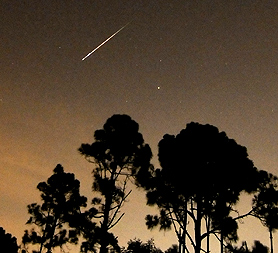Spectacular Perseids meteor shower due
This year’s Perseids meteor shower promises to be particularly spectacular. Channel 4 News Science Correspondent Julian Rush has tips on how and where to watch the beautiful display.

This year’s display of the annual Perseids meteor shower looks like being one of the best for many years.
Largely clear skies are forecast and crucially we are just two days past the new moon, so there is little or no moonlight to blot out the fiery display.
Over tonight – August 12-13 – the shower will reach its peak as the Earth passes through the ice, dust and debris that is the tail of Comet Swift-Tuttle.
The meteors – bright streaks in the night sky – are the tracks of the particles as they burn up in the atmosphere.
The comet swings through the inner solar system every 133 years – it was at its closest to the Sun in 1992 so the tail is still fairly dense, making for a particularly spectacular display.
You can see some of this year’s photos on the SpaceWeather website.
Where and how to watch
First you need to be somewhere where there is little light pollution; inner city star-gazers will still be able to see some shooting stars, around ten an hour at the peak, but out in the countryside where the skies are darker will be much better, where 60 to 100 an hour should be seen.
The National Trust has put together a list of good places to go.
Get out your woolly jumper, your deck chair and your thermos flask of tea and sit facing north-east, looking up at around 45 degrees into the sky.
For those of you who know your constellations, look near Cassiopeia. This year, the display will start as soon as it gets dark at around 10pm, peaking between midnight and 1am.
You can join in too and record your sightings for the British Astronomical Association’s Project Perseid 2010.
The BAA’s Meteor Section Director Dr John Mason says: “Project Perseid 2010 will provide important information about the dust which causes the meteors, allowing us to better predict future showers. Anyone can submit observations by using the guidance notes and observing form available on our website, and so take part in real science.”
And for the first time this year, you can follow the Perseids on Twitter. Adrian West (@VirtualAstro) has set up Twitter Meteorwatch (use the hash tag #Meteorwatch) where, he tells me, amateur and professional astronomers alike are swapping tweets and links to images of what they’ve seen.
West will be watching from his garden shed, which he says is also known as the ‘astro bunker’, and says: “There won’t be loads of telescopes, it will just be me and the internet.” And he urged everyone to try and get involved.
“You don’t have to have scores of astronomers or scientific knowledge. You don’t need to be a professor, a doctor, or a scientist to enjoy the shower.
“Just make sure you are comfortable and spend some time outside, looking up. Over the past few nights, people have seen meteors for the first time in their lives. What we are trying to do is encourage them to enjoy the wonders of the night sky.”
-
Latest news
-
Laughing Boy: New play tells the tragic tale of Connor Sparrowhawk5m

-
Sewage warning system allows some of worst test results to be left off rating system, analysis shows3m

-
Post Office inquiry: Former CEO didn’t like word “bugs” to refer to faulty IT system4m

-
Israeli soldier speaks out on war in Gaza12m

-
PM’s defence spending boost should be ‘celebrated’, says former Armed Forces Minister4m

-




